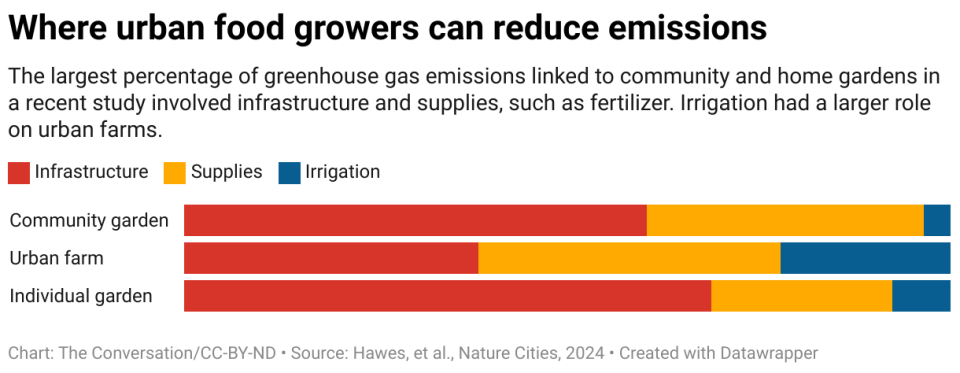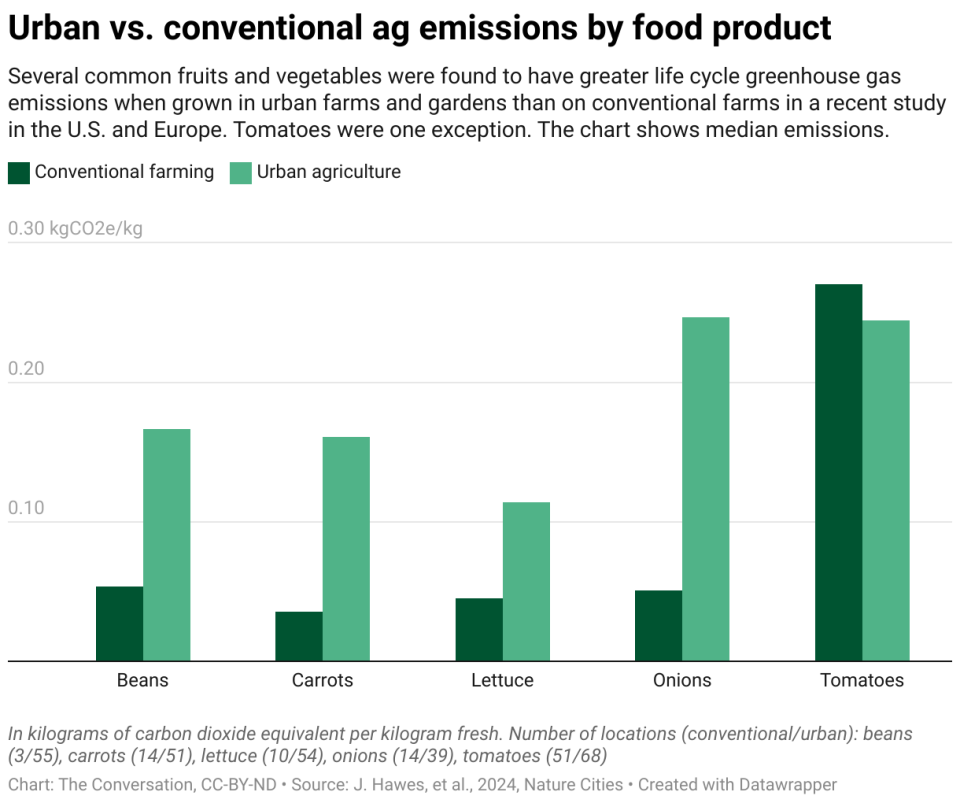Urban agriculture is expected to be a key feature of 21st century sustainability and can provide many benefits for communities and cities, including providing fresh produce in neighborhoods with few options.
Among these benefits, growing food in backyards, community gardens, or urban farms can shorten the distance fruits and vegetables must travel between producers and consumers; This is called a “foodway” problem. It would be a small step to assume that urban agriculture is a simple climate solution once transportation’s greenhouse gas emissions are eliminated.
So is urban agriculture really as climate-friendly as many people think?
To test this hypothesis, our research team partnered with individual gardeners, community garden volunteers, and urban farm managers at 73 sites in five countries in North America and Europe.
We found that although urban agriculture has many social benefits, it is not always better than conventional agriculture in terms of climate throughout its life cycle, even when transportation is taken into account. In fact, the urban agricultural areas we studied were six times larger on average. More carbon intensive per serving of fruit or vegetable than conventional farming.
But we also found some applications that show how effectively fruit and vegetables grown in cities can be made more climate-friendly.
What makes urban agriculture more carbon intensive?
Most research on urban farming has focused on single types of urban farming, which are often high-tech projects such as aquaponic tanks, rooftop greenhouses, or vertical farms. Electricity consumption often means that food grown in these high-tech environments has a large carbon footprint.
Instead, we looked at the life cycle emissions of the more common low-tech urban agriculture (the kind found in city backyards, vacant lots, and urban farms).
Our study, published on January 22, 2024, modeled carbon emissions from farming activities such as irrigation and fertilization of crops and the construction and maintenance of farms. Surprisingly, from a life cycle emissions perspective, the most common source at these sites turned out to be infrastructure. From raised beds to sheds to concrete pathways, this gardening infrastructure means more carbon emissions per serving of produce than the average wide-open spaces on traditional farms.
But among 73 facilities in cities including New York, London and Paris, 17 had lower emissions than traditional farms. By exploring what sets these areas apart, we identified best practices for reducing the carbon footprint of urban food production.
1) Use recycled materials, including food waste and water
Using old building materials, such as raised beds, in building farm infrastructure can reduce the climate impacts of new timber, cement and glass, among other materials. We found that upcycling construction materials can reduce a facility’s emissions by 50% or more.
On average, 95% of synthetic nutrients in our facilities have been replaced by compost. Using food waste as compost can avoid both methane emissions from food scraps buried in landfills and the need for synthetic fertilizers made from fossil fuels. We found that careful compost management can reduce greenhouse gas emissions by approximately 40%.

Collecting rainwater or using gray water from shower drains or sinks can reduce the need for water pumping, water treatment and water distribution. However, we have found that very few facilities use these techniques for most of their water.
2) Grow crops that are carbon intensive when grown conventionally
Tomatoes are a great example of a crop that can reduce emissions when grown using low-tech urban agriculture. They are often grown commercially in large-scale greenhouses, which can be particularly energy intensive. Asparagus and other produce that must be transported by plane because they spoil quickly are another example with a large carbon footprint.


Low-tech urban growers can reduce their net carbon impact by growing these crops instead of buying them in stores.
3) Ensure the long-term survival of urban gardens
Cities are constantly changing and community gardens can be vulnerable to development pressures. But if urban agricultural areas can remain in place for many years, they can eliminate the need for new infrastructure and continue to provide other benefits to their communities.
Urban agricultural areas provide ecosystem services and social benefits such as fresh produce, community building and education. Urban farms also provide homes for bees and urban wildlife, while providing some protection against the urban heat island effect.
The practice of growing food in cities is expected to continue to expand in the coming years, and many cities see it as an important tool for climate adaptation and environmental justice.
We believe that through careful site design and improved land use policy, urban farmers and gardeners can increase their benefits to both nearby people and the planet as a whole.
This article is republished from The Conversation, an independent, nonprofit news organization providing facts and analysis to help you understand our complex world.
Written by Jason Hawes university of michigan; Benjamin Goldstein, university of michiganand Joshua Newell, university of michigan.
Read more:
Benjamin Goldstein receives funding from the Natural Sciences and Engineering Research Council of Canada.
Jason Hawes and Joshua Newell do not work for, consult for, own shares in, or receive funding from any company or organization that would benefit from this article, and they have disclosed no relevant affiliations other than their academic appointments.